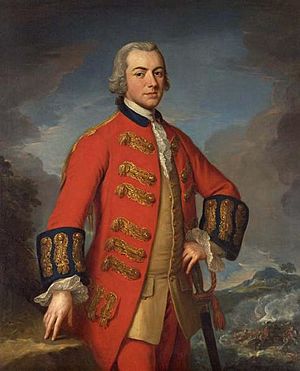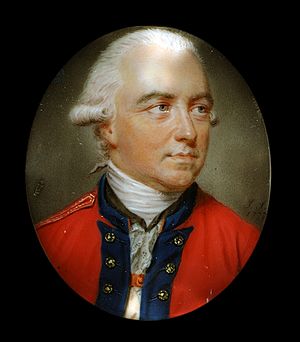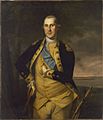Henry Clinton (British Army officer, born 1730) facts for kids
Quick facts for kids
Sir Henry Clinton
|
|
|---|---|
 |
|
| Allegiance | Great Britain |
| Service/ |
British Army |
| Years of service | 1751-1793 |
| Rank | General |
| Commands held | Commander-in-Chief, North America |
| Battles/wars | Seven Years' War American Revolutionary War |
| Awards | Knight of the Bath |
| Other work | Member of Parliament |
General Sir Henry Clinton was an important British army officer and politician. He is best known for his role as a general during the American Revolutionary War. For most of this war, he was the main British commander in North America.
Besides his military career, he also served as a Member of Parliament (a type of lawmaker) and as the Governor of Gibraltar. He came from a noble family with a long history of serving the British Crown. His father was a high-ranking naval officer, and his two sons also became generals.
Contents
Early Life and Military Start
Henry Clinton was born in Newfoundland, a part of Canada today. His father was the governor there. Henry mostly grew up in New York, where his father was the Royal Governor from 1741 to 1753. Both Henry and his father got help in their careers from powerful friends, especially the Dukes of Newcastle.
Around age 18, Henry Clinton served in the New York local army. In 1751, he moved to England and joined the British Army. His family helped him buy his way up through the ranks. He became a Captain in the Coldstream Guards and later a Lieutenant-Colonel.
During the Seven Years' War (1760-1762), Clinton showed he was a good soldier. He worked closely with Duke Ferdinand of Brunswick and was promoted to Colonel. After the war, he was given command of a regiment. In 1772, he became a Major-General. That same year, he became a Member of Parliament thanks to his cousin, the Duke of Newcastle. He stayed in Parliament until 1784.
Leading in the American Revolutionary War
In March 1775, King George III sent Clinton and other generals to the Thirteen Colonies to help the British forces. The American Revolutionary War had just begun.
Early Battles and Challenges
On June 17, 1775, Clinton was one of the British leaders at the Battle of Bunker Hill near Boston. The British won, but they lost over 1,000 soldiers. Clinton warned that the Americans might fortify other hills, but his advice was not followed. In March 1776, the Americans did fortify those hills, forcing the British to leave Boston and go to Halifax, Nova Scotia.
In June 1776, Clinton led an attack on Fort Sullivan in Charleston, South Carolina. This attack was a big failure. Clinton had underestimated how strong the American forces were. The British navy also tried to attack Fort Moultrie, but it was too strong, and their ships were badly damaged. This campaign in the Carolinas was then called off.
Later in 1776, Clinton joined General Howe's attack on New York City. Clinton suggested a plan to attack up the Hudson River, but Howe disagreed. However, Clinton's new plan for the Battle of Long Island was followed and worked very well. For this success, Clinton was promoted to lieutenant general and given a special award, becoming a Knight of the Order of the Bath.
In December, Clinton led 6,000 men to take over Newport, Rhode Island, which he did quickly.
Becoming Commander-in-Chief
In May 1778, after the British lost the Saratoga Campaign, Clinton became the main British commander in North America. He took command in Philadelphia. By this time, France had joined the war to help the Americans. Because of this, Clinton was ordered to send 5,000 of his soldiers to the Caribbean. This meant he had to leave Philadelphia.
He skillfully led his army in a retreat from Philadelphia to New York. During this retreat, they fought a battle against George Washington's army at Monmouth on June 28. Once in New York, Clinton started sending smaller groups of soldiers out from the city. Before the end of 1778, he sent an army south to attack Georgia. This force captured Savannah, Georgia in December, and by early 1779, they controlled the area around it.
The British hoped that many American Loyalists (people who supported Britain) in the South would join them. While some people in the South were less keen on independence, the big wave of support the British hoped for never happened. This left Clinton's forces feeling a bit alone.
By late 1779, Clinton gathered a strong force for the next step: invading South Carolina. Clinton personally led this campaign. His army of 14,000 men sailed south from New York. By early 1780, Clinton had surrounded Charleston. In May, working with Admiral Mariot Arbuthnot, he forced the city and its 5,000 soldiers to surrender. This was a huge defeat for the American rebels. However, during this time, Clinton and Admiral Arbuthnot did not get along well. This problem of not working well with other high-ranking officers would continue throughout the war.
Clinton then went back to New York. He left 8,000 British soldiers in the South under the command of General Cornwallis, his second-in-command. From New York, Clinton watched over the war in the South. He wrote many letters to Cornwallis, showing he was very interested in what his southern army was doing. But as the war went on, their relationship became more difficult. Their letters became more and more angry. Some people think this was because another British official, George Germain, might have encouraged Cornwallis to ignore Clinton's orders.
In 1782, Clinton was replaced as Commander-in-Chief by Sir Guy Carleton. Clinton then returned to England. His replacement happened after the British army in the South, led by Cornwallis, was surrounded and forced to surrender by George Washington and the French-American army at the Siege of Yorktown.
Later Life and Legacy
In 1783, Clinton tried to clear his name by publishing a book about the war called Narrative of the Campaign of 1781 in North America. This book made Lord Cornwallis very angry. Clinton also returned to Parliament until 1784.
Not much is known about what Sir Henry Clinton did from 1784 until 1790, when he was re-elected to Parliament. In October 1793, Clinton was promoted to full general. The next year, he was appointed Governor of Gibraltar, but he died before he could start that job.
Sir Henry Clinton was in command in America for four years. The war ended in disaster and defeat for the British. For a long time, his name was linked to the loss of the American colonies. However, historians today often put more blame on Cornwallis.
Clinton published his Narrative to try and improve his reputation. One officer who served under him said Clinton was "an honorable and respectable officer." But he also said Clinton was "vain, open to flattery," and sometimes "misled by aides de camp." Another officer, Sir Charles Stuart, called him "fool enough to command an army when he is incapable of commanding a troop of horse." Clinton found it hard to work with others and often argued with naval commanders.
Images for kids
-
John Trumbull's The Death of General Warren at the Battle of Bunker Hill. Clinton is in the center background, bareheaded and holding a sword.
-
William Howe (1777 mezzotint) came to dislike Clinton during the 1776 campaign.
-
Commanding General George Washington, Continental Army
See also
 In Spanish: Henry Clinton para niños
In Spanish: Henry Clinton para niños






